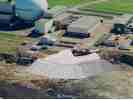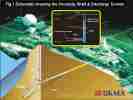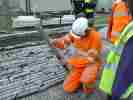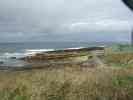|
As part of the enabling works required for the shaft isolation project, approximately 150metres of the Dounreay’s low active drain (LAD) adjacent to the shaft had to be diverted. At the end of September the tie-ins operation to connect the old and new LAD were carried out and the system commissioned. The LAD diversion required the creation of a new reinforced concrete duct, some 158 metres long, containing stainless steel pipework and secondary containment.
Over two days approximately 30 UKAEA and contractor staff worked together to complete many of the intricate parts of the project, linking the new to the existing LAD. Due to the nature of the work staff were required to wear airline suits and all operations were carried out within a radiological containment called EREC (Environmental and Radiological Enclosure), which was specially constructed by RWE Nukem using their Moducon system. George Polson, project manager, said: “This very important stage of the project was completed due to the excellent team work and active cooperation between UKAEA staff and contractors. Contractors wore airline suits to carry out the tie-ins, with UKAEA operations group observing to ensure all procedures were followed. I commend all involved with this project. This is a perfect example of how contractors can work together.” Part of the LAD diversion is now complete and all that remains is for the surrounding area to be levelled and landscaped. The remaining area still has major work to be completed. The contract is not only to divert the LAD but also involves stripping away tonnes of soil, taking the ground back to rock level, and diverting existing electrical and mechanical services. Diverting and re-locating all the services which run between the shaft’s sediment tank building and the shaft to an above ground concrete service duct, will allow the shaft isolation project visibility of these services when they commence work on isolating the shaft, building the raised working platform and drilling boreholes. Eventually the services will be raised to the level of the raised working platform to allow future maintenance access. All the liquid travelling from the shaft to the shaft’s sediment tank building will be pumped into the new LAD through double-braided flexible hoses via the same route as the new services. Paul Corrigan, project engineer, said: “The use of double-braided hoses rather than stainless steel pipe work not only has the advantage of providing us with the required secondary containment, but also the flexibility to move the pipework and the concrete duct if required.” Excavation of the tonnes of soil will commence at the end of November, although the bulk will not be removed until early next year. Work will commence shortly on removing the redundant section of the LAD, again operators will be required to wear air-line suits for this operation and will work in the radiological containment EREC. The redundant section of LAD will be cut into removable sections using the process of diamond wire cutting in dry conditions, to avoid the introduction of water. Trials on this method were successfully carried out earlier this year on a constructed replica of the LAD. The drain will be cut up into manageable pieces and stored in half-height (HHISO) containers. The £2.75 million contract was awarded to Edmund Nuttall Ltd with sub-contractors JGC Engineering & Technical Services Ltd, RWE Nukem, Environmental Reclamation Services Ltd and Clyde Valley Drilling and is due for completion in March 2006. |





